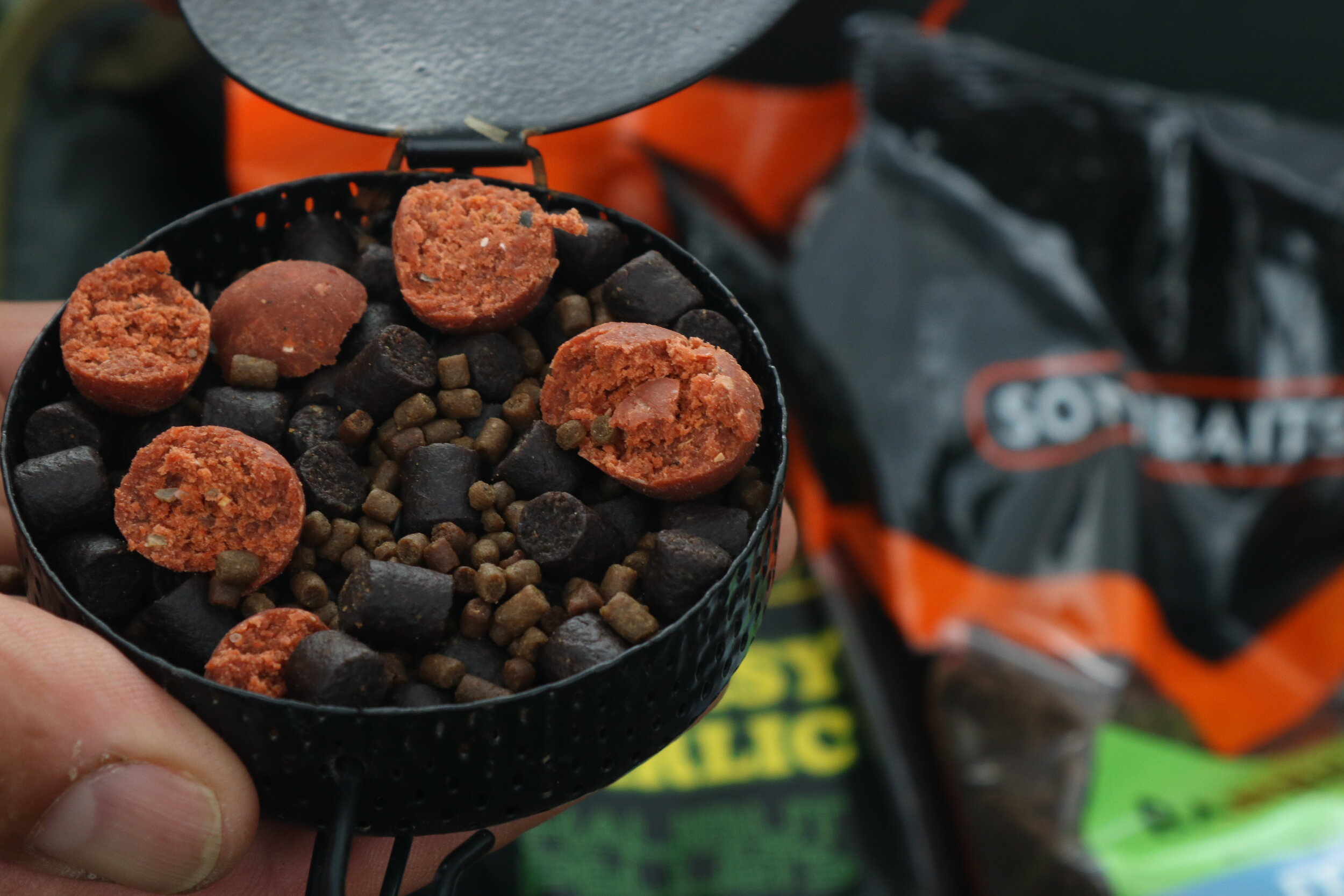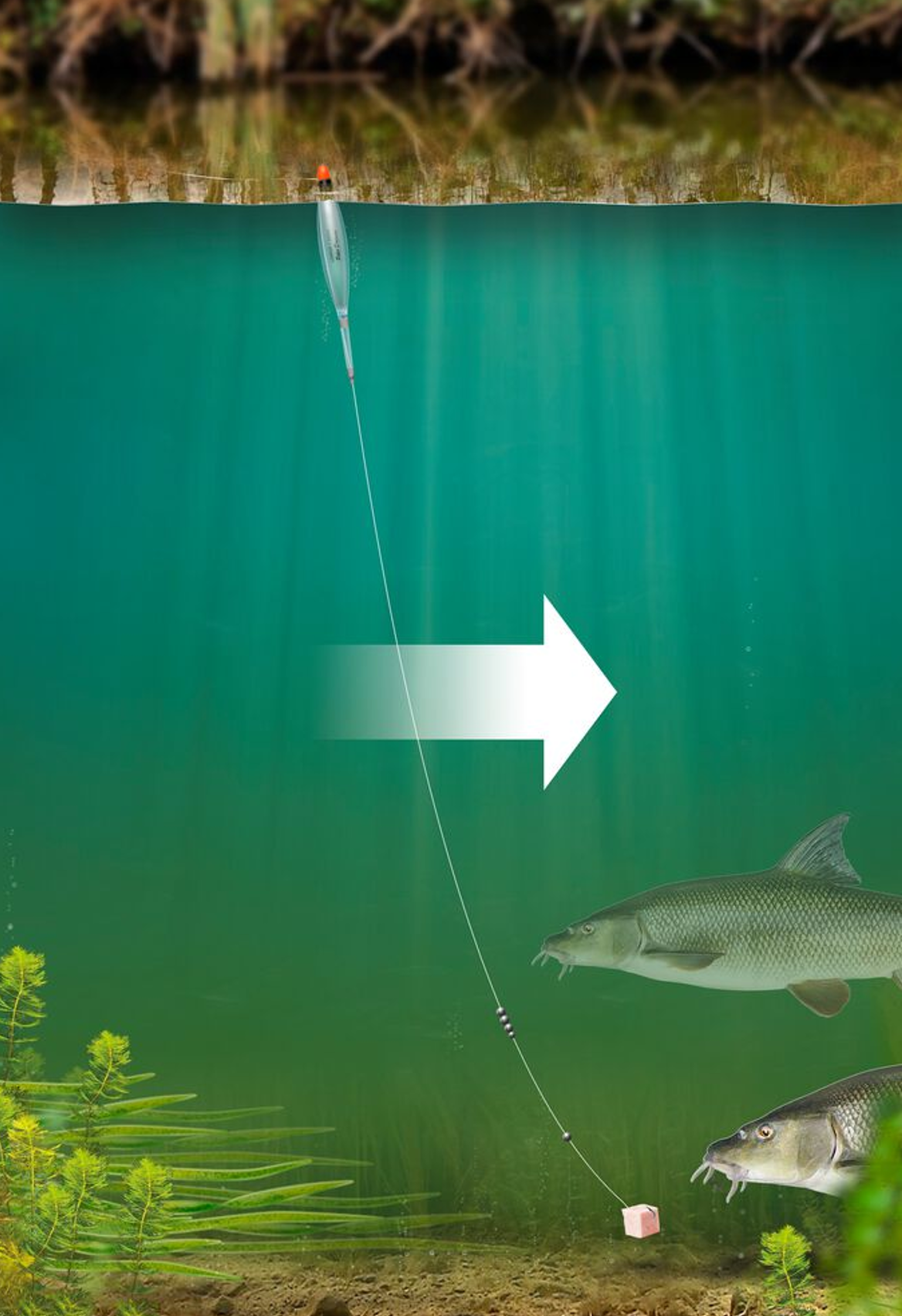River Fishing Tips | How to find barbel on a flooded river - Dai Gribble
In prolonged floods, barbel seem to gradually move out of the main flow into slower flowing water. I suspect this coincides with them having fed well and preferring to rest up in areas where they need to expend less energy.
Barbel will move away from fast flows in prolonged floods
This helps you locate the barbel as once the river has been in flood for a couple of days, they are more likely to be found in the classic flood swims where the flow is less than in the main river.
I’d look for the following:
Bends with slack water on the inside and a crease where the main flow passes by.
Cattle drinks where there is slow-flowing or slack water out of the main current.
Slacker water behind overhanging obstructions such trees.
Deep holes where the barbel can lie in slower flows beneath the main pace of floodwater.
Slacks downstream of large bridge supports.
Search out slacker areas of water for barbel in times of flood
River Fishing Tips | How to bait for barbel - Dai Gribble
I prefer a bait dropper over making lots of casts with a feeder because it’s accurate and often much quicker too.
A bait dropper is a quick and accurate way to feed a barbel swim
I bait up with different-sized pellets and a few crushed boilies. The pellets keep the fish in the swim for long spells while the crushed boilies give them a taste of my hookbait.
Use a real mix of pellets to keep the fish in the swim for longer
Crushing the boilies releases lots of flavour. I’ll introduce around a pint of mixed barbel pellets and 30 crushed boilies, the exact amount depending on several factors…
The size of the river - The bigger the river I’m fishing, the more bait I will use.
Large well stocked rivers like the Wye, Trent and Severn require heavier feeding
Stock of barbel and other species - if I know there are a lot of barbel, chub, or even silverfish such as roach I will up the amount of feed I put in at the start.
If there are lots of fish they will need more feed
Temperature - As temperatures drop towards autumn, I will scale back on the amount of bait being fed.
Scale back the feed as temperatures drop
How long I am fishing for - The longer my session, the more feed I will introduce.
If you are fishing a long session, try a bait and wait approach
Specimen Fishing Tips | The best crucian float rig - Dai Gribble
A common mistake is to use a float that is too light, which makes casting difficult and is very likely to be dragged out of position by the wind or undertow.
Select a float that allows you to easily cast past the spot you are fishing and wind it back into position, sinking the line as you do so by pushing the rod-tip underwater.
A straight peacock or crystal waggler is my float of choice, but I will switch to an insert waggler with a finer tip if bites are finicky.
In terms of size, a float carrying 4AAA is a good starting point in water 6ft-8ft deep and I lock it in place with two movable float stops. I’ll then have an AAA shot at half depth and a BB and several No4s spaced between the AAA and the hook.
I like to present my hookbait slightly overdepth with about 4ins of line laid on the bottom. If there’s a lot of undertow, place a No6 shot just on the bottom. With this set-up the bites are usually very positive, with the float often rising slightly before disappearing under the surface.
Dai Gribble and a 3lb-plus crucian
River Fishing Tips | Cage or solid feeder for barbel? - Dai Gribble
As well as carrying feeders of different sizes and weights, it pays to have different types in your tackle box so you can vary the rate at which your feed is released into your swim.
Cage and solid feeders both have uses in barbel fishing
A cage feeder will empty much quicker than a traditional, solid-style feeder with just a few holes. So, If bites are coming soon after casting, opt for a cage feeder so that the bait is deposited rapidly int the swim, otherwise the feeder will still be full while you are playing a fish and will end up emptying its contents across the river.
Cage feeder barbel fishing rig
If bites are slow in coming, however, it pays to use a solid, slower-release feeder to ensure bait is trickling past your hookbait and down to the fish for much longer.
A cracking River Severn barbel
River Fishing Tips | The best float rig for barbel - Dai Gribble
SOME people favour using big wagglers, especially if it’s windy, but most of the time when trotting for barbel I use two types of float – Chubbers and Avons.
I use both Chubbers and Avons
Avon floats, with their large shoulders and heavy wire stems, are best suited to deeper water and slower flows, while the more streamlined Chubbers, or Loafers as they’re sometimes called, work best when used in shallower, faster water.
It’s important to use a big enough float to boss the river, rather than letting it boss you, so I rarely use a float with less than 3AAA loading and, depending on flow and depth, I will use them as big as 5SSG.
I start with the bulk of the shot set 50cm-60cm from the hook, with a single dropper shot, generally a BB, between the bulk shot and the hook.
A standard barbel float rig
Although barbel will sometimes take a bait presented off the bottom, I want my bait running along the bed of the river as that is where it is most likely to be taken, so my shotting is designed to get the bait down to the feed area as quickly as possible.
They are great fun on the float!
Specimen Fishing Tips | Five rigs to try in 2020 with Dai Gribble
YOU need to have full confidence in the rigs you use. Big fish are generally thin on the ground – that’s one of the main reasons why they are big, and on occasions you can be waiting days or even weeks for a bite. You don’t want to slip up now!
In such circumstances you will be more focused if you believe you are using the right rig for the job. Here are five rigs that I use a lot and can recommend without hesitation.
1: Helicopter Rig
This rig has a short hooklink that spins around the mainline. It is my first choice for stillwater feeder fishing as it very rarely tangles and is very efficient at turning bites into hooked fish. Invariably the mainline is under slight tension due to undertow caused by wind, and this makes it difficult for fish to eject a bait once they have taken it.
2: Flatbed Method
No rig presents a bait better than the flatbed Method feeder, as the hooklink is completely buried within groundbait and this groundbait draws fish directly to the hookbait. It is ideal for fishing inert baits such as pellets, corn and boilies. Try different liquids in the groundbait and use Sonubaits Lava Rocks to draw fish to the feeder.
3: Korum Running Rig
I use this rig for nearly all my barbel fishing with both leads and feeders. The rig casts really well without tangling, thanks to the clever design which pushes the feeder or lead away from the hooklink. I always use hooklinks with a loop, as the quick-change swivel allows you to change them in seconds by sliding the tapered sleeve off.
4: Simple link leger
Very often simple is best, and rigs don’t come much simpler than this – a leger bead with a piece of line with shot attached, stopped by a couple of float stops and the hook tied direct to the mainline. By adding or removing SSG or AAA shot it is really easy to get the perfect presentation for the swim you are fishing, making this rig perfect for much of my chub and perch fishing.
5: Bolt rig for eels
One of the biggest challenges facing the eel angler is avoiding deep hooking while at the same time not missing runs. When eels are feeding on small baits such as maggots the bolt rig is the solution. A small, strong hook baited with
a bunch of maggots on a 3ins braided hooklink combined with a 2oz inline lead has served me very well, with few dropped runs and every eel I landed hooked perfectly in the bottom lip.



















